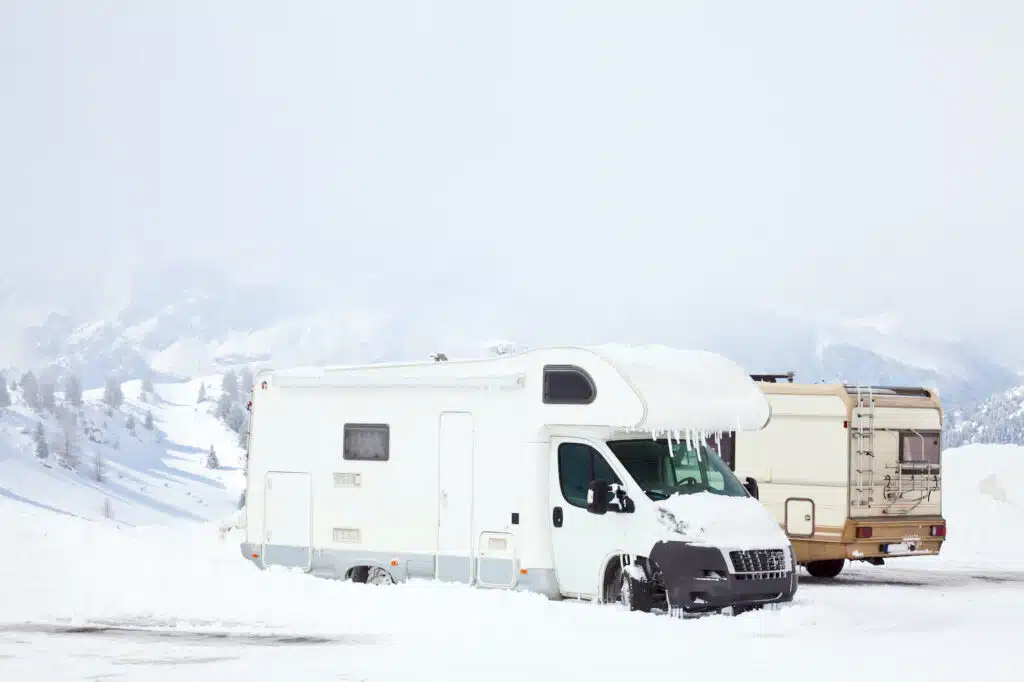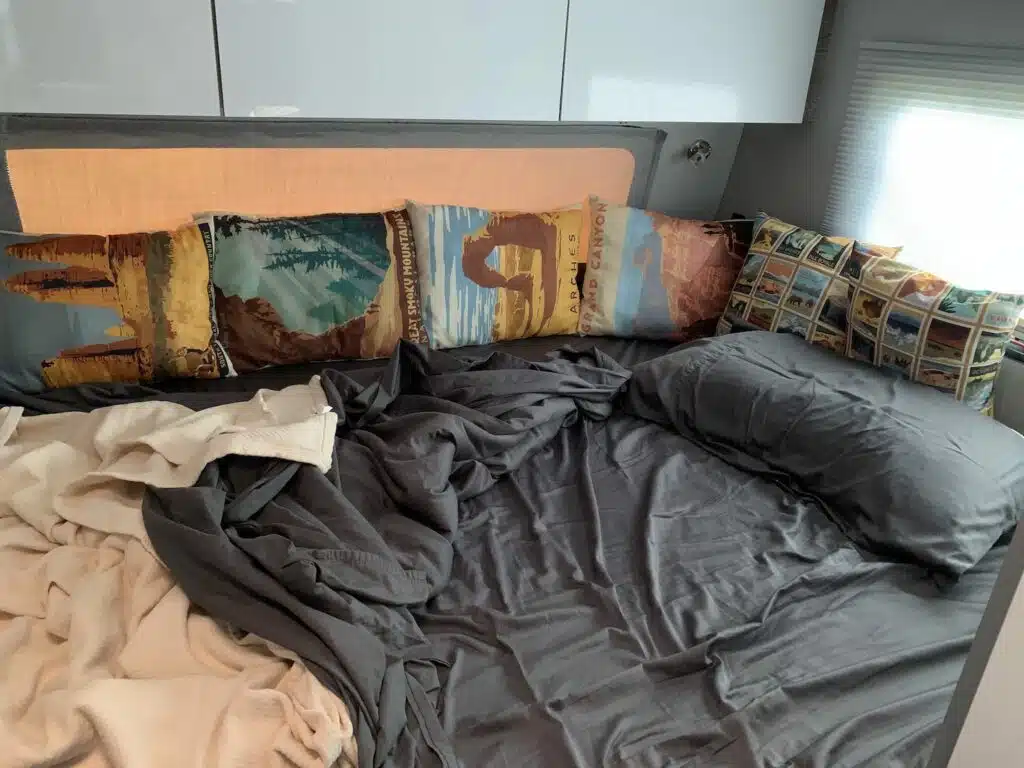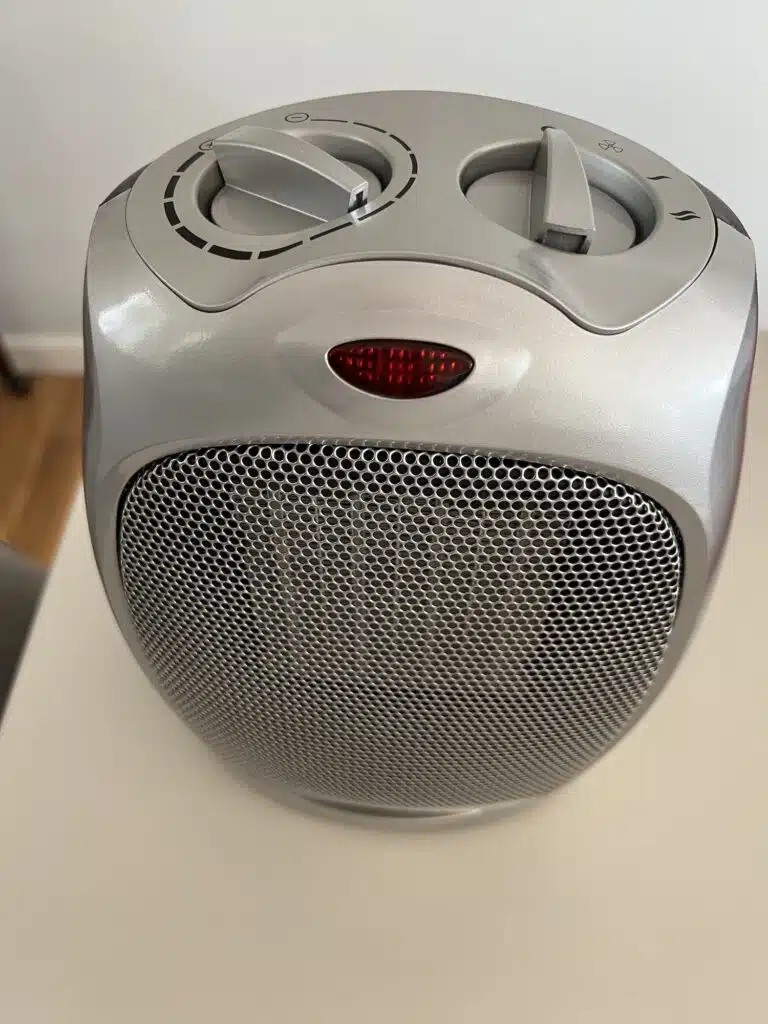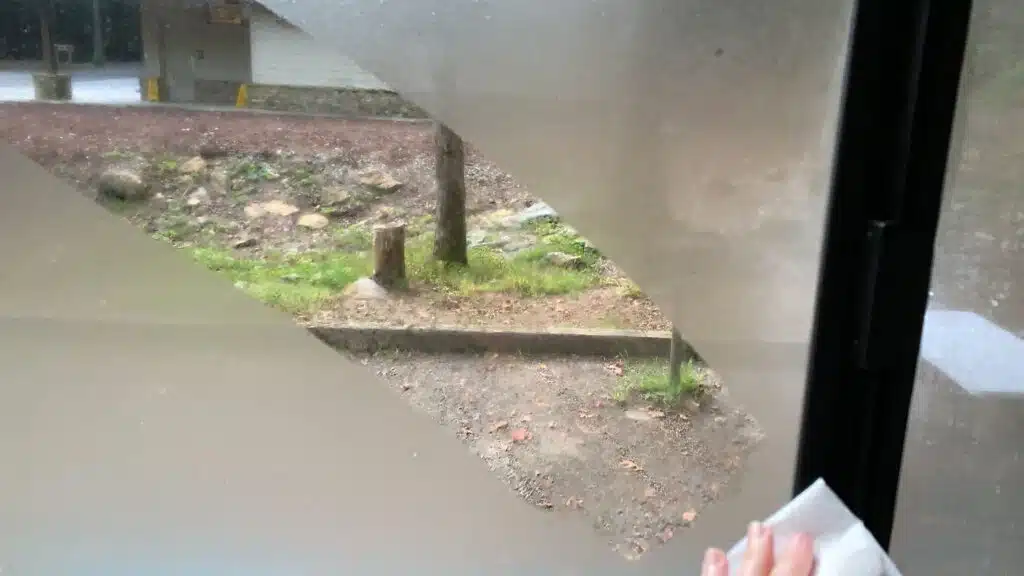If you make a purchase using links in this article, I could receive a commission. Please see my Privacy Policy for information.
I have spent many a night shivering in bed in our RV as I impatiently waited for morning to come so that we get in our towing vehicle, turn on the heat full-blast, and leave. We have been surprised at unexpectedly cold temperatures while camping across the Southwest in Spring, as well as dealing with freezing temperatures when parked long-term as we were full-time RVing.
Let’s face it, RVs are not going to be as warm and comfortable as a home unless you prepare ahead of time. You need to invest in a few smart items to keep you warm, and know some clever hacks to increase the temperature inside your camper.
Over the years, we have discovered the best ways to stay warm and comfortable, even when the weather outside is frightful.

These tips are not intended to winterize your RV for full time living in cold climates. While they can be used for full-timing, we suggest making modifications to your rig to withstand months of cold weather, such as adding RV skirting to keep the cold out.
Instead, these methods to keep you and your RV warm have been personally tested by us as we were surprised with cold weather during our travels (especially when fall camping) or were unable to avoid a few nights of freezing temperatures on our itinerary.
Protect Yourself From Exterior Walls
There is not much insulation in the walls of most RVs. Which makes the walls very cold during winter weather.
The further you can stay away from the walls, the less exposure you will have to the cold temperatures radiating off of them.
This is especially true in an RV bed. If your bed is situated against exterior walls, you will be cold all night long unless you do something about it.
This was one of my biggest complaints of our Intech Sol Horizon. We camped a lot in cold weather and the three walls surrounding our bed were cold to the touch all night long.
I used towels, pillows and blankets to stuff against the walls as a type of insulation from the cold. It worked really well and improved the quality of our sleep.

Use a Portable Electric Heater
After too many nights freezing inside our RV, we ordered this portable electric heater to be delivered to our KOA in Utah and are so glad we did!

The first night we plugged in our heater we couldn’t believe the difference! We were suddenly warm and toasty and not miserable!
We have since bought this Amazon ceramic heater and are very happy with how well it works, too.

Portable electric heaters work great with electric hook-ups. However, even if you have a portable power pack, you can get some relief from the cold temperatures, as we shared in our video of how we use our Jackery.
This is just one of the heaters we recommend for safe tent heaters for camping, too.
(You might also like our guide to how to insulate a tent for winter camping.)
Park in the Right Spot
How you park your RV can make a difference in how cold you will be. Work with Mother Nature, not against her, to stay warmer in your rig.
If possible, park with some wind protection. Cold winds can make it feel even more miserable indoors. This could be as simple as parking behind a fence or tree line. Or you might want to start looking at the direction of the winds and park accordingly to avoid them.
Sunlight is naturally warming, and you want to get as much solar heating as possible. You do not need solar panels to benefit from the power of the sun.
Do not park in a shady spot. You want to park where the sun will be shining on your travel trailer or motorhome as long as possible. Those sun rays will heat up the trailer and help to melt any ice that may have formed.
Take a Hot Shower
Showering can increase your body’s internal temperature. Taking a hot shower can help you feel warmer for up to an hour afterwards.
Instead of opening the ventilation fan in the shower, you can let the moist heat escape into the RV to heat the indoors.
Electric Blanket
An electric blanket is perhaps the easiest way to keep warm all night long when sleeping or when curled up while watching TV in your RV. Low-wattage electric blankets are easy to find, which is a good thing for using in a camper.
There are electric blankets with 12V plugs for easier use in vehicles, vans and campers.
An electric throw blanket can be just as helpful if you don’t want to spend the money on a larger blanket. Keep this small throw on your feet or over your chest to feel warm.
Battery Powered Electric Blanket
For off-grid camping in the cold, you may need a battery-operated heated blanket rather than using a corded blanket.
Electric Mattress Pad
If you worry about kicking off an electric blanket, or sleep with someone who is a blanket-hog, an electric mattress pad makes more sense for you.
This thin pad is put on top of your mattress, either under or over your sheets. You will sleep on top of it.
Keep in mind that most mattress pads are made for standard size beds. If you have a Queen short mattress or other unique RV mattress size, be sure to measure dimensions and purchase one that will fit your specific bed.
Hot Water Bottle
This old-school way of staying warm is still one of the easiest, cheapest and most effective solutions.
Even if you do not have power, you probably have the ability to heat water.
Add hot (not boiling) water to a hot water bottle and apply to your body or put in your bed. The radiant heat will warm up your sheets and keep you warm without any electricity or propane.
Electric Heating Pad
Just like an electric blanket or mattress pad, an electric heating pad is a low-wattage way of staying warm.
Heating pads are smaller, and usually a little less expensive, than a large blanket or pad. They can be easier to store and bring with you compared to larger bedding items.
While heating pads won’t cover your entire body, they can be applied to your neck, back or core to keep you warm.
Layer Blankets
You need multiple layers of blankets to keep the heat in on your bed. Don’t complain about being cold if you just have a comforter and that’s it.
Every camper should have at least one light-weight blanket and one heavy-weight blanket year round. Layer these two blankets on top of each other to stay warm during the winter, as well as any other blankets you may have.
Dry towels laid over your blankets can add another extra layer of warmth. This is what I have done multiple times when cold in our travel trailer and you would be surprised at how well they work.
Use the Right Type of Blanket
Natural fibers and wool blankets are always recommended for staying warm in the winter. However, I have found the best way that we stayed warm in our RV was using cheap, polyester blankets from Walmart.
These are the blankets we bought at Walmart in Elk City, Oklahoma after an especially cold winter night camping on Route 66.
We had no idea if they would be good or not, but they were cheap and one of the few things available. Turns out these are some of our favorite blankets for staying warm, even at home!
Because they are polyester, they don’t breathe as well. Which means they trap in heat. In our cold circumstances, that worked in our favor and we have used them every single night since buying them! We could not be happier with this purchase!
Keep Blackout Curtains Closed
A lot of cold can come in through the windows. Especially single-pane windows used on RVs.
Keeping curtains drawn and closed is a layer of insulation to keep cold air from circulating inside.
We used blackout curtains in both of our RVs and they work great at keeping hot air outside during the summer and cold air from coming inside during the winter.
See my video tutorial on how I made DIY blackout curtains for our RV.
If you don’t have fabric blackout curtains and only have the honeycomb blinds, consider hanging towels and blankets over your curtain rods to block out the cold temps. We have done this on multiple occasions and it really makes a difference!
Use Hot Packs
Hot packs, often used for your hands, feet or around your neck, can keep you warm without the need to plug in a heating pad.
DIY rice packs can be heated in the microwave to get hot.
Reusable hand warmers can be charged with a power station.
Even the disposable hand warmers and foot warmers can last several hours and keep your extremities warm, which then in turn warms your entire body.
Temporary Skirting Around RV
RV skirting is important for winter camping because it stops cold winds and drafts from entering your camper from underneath. However, it is best used when parked in one location for several days or months.
You can make temporary skirting by putting up tarps to prevent cold winds from blowing underneath your travel trailer or motorhome.
Sheets of plywood and bales of hay are also ways that other people have temporarily blocked cold weather from their RV. We have not personally tried this and don’t know how effective it is.
Wear More Clothes and the Right Types of Clothing
Absolutely do not complain about being cold in your RV if you are wearing a t-shirt and thin pants. Sorry, you have got to dress appropriately to stay warm.
Even in our home we wear sweatshirts and fleece-lined pants to stay warm in the winter!
We have found that layering clothing is the best way to stay warm. Multiple thin layers of clothes seems to work better than one thick layer of clothing.
Consider wearing thermal leggings or a thermal top underneath your pants or sweater. Then add a lightweight sweater vest or jacket on top.
Fleece clothing keeps us much warmer than natural fibers such as cotton or even wool. We prefer investing in inexpensive fleece jackets and sweatshirts rather than expensive wool sweaters.
Make Sure You Have Enough Propane
The number one way to stay warm is to use your heater. And you can’t use your propane heater if you run out of propane!
If you know that colder weather is coming, be absolutely sure to check your propane tanks before getting to your destination. You will want to check levels while you are in an area that offers propane refills, since many locations do not have propane.
A propane tank monitor is the best solution to know how much LP you have at any time.
Use a Generator
Did you know that even propane heaters need some source of power to get them to work? That’s right, you need to have some sort of electricity in order to power your RV’s heating system, even though the heater runs off of propane.
Bring a generator with you for times when you need off-grid power. Here are some of the best generators we suggest.
Camp with Hook Ups
A lot of ways to stay warm in an RV rely on electricity. You need electricity, whether plug-in shore power or solar, to stay warm.
If you don’t have solar power, be sure to camp at an RV site with electric hookups.
For rigs with off-grid solar power, make sure your system can keep up with the heavy demands.
Use a Heated Water Hose
You need water. Period. And if your water hose freezes in unexpected conditions, then you can’t flush your toilet or wash your hands. If you’re planning to spend time in colder regions, we suggest purchasing a heated water hose.
Which means you will need to go outside every time you need to use the bathroom. And that’s a surefire way to stay cold!
A heated water hose that supplies potable water to your RV has an integrated low-voltage electrical element running the full length of the hose. This unique type of hose does require an adjacent 120V power source and many of the top of the line models have integrated temperature regulation systems to deliver heat when required and can be used in frigid temperatures down to -20 degrees Celsius or -4 degrees Fahrenheit.
Drink Hot Liquids
Ingesting hot liquids, such as hot tea, hot cocoa or even broths can help warm you from the inside out.
Eat Hot Foods
Indulge in hot foods rather than cold sandwiches to stay warm. The act of cooking foods can increase the amount of heat in your camper, too.
Faux Fireplace on TV
There is something about the mind-body connection that can dramatically affect your well-being. Just watching a fake fireplace video on Youtube can give you the sense of warmth and comfort, even when the temperature doesn’t change inside your camper.
You wouldn’t want to watch a movie with icebergs and snow drifts while you were cold, because it would be miserable. So why not watch a Youtube fireplace video, or any movie set in a tropical location. It can trick your body into feeling just a few degrees warmer.
Wear a Hat Inside
You lose a LOT of heat through your head. Wear a beanie hat inside your trailer or van to stay warmer.
Wear Socks
You can’t complain about being cold if you are not dressed appropriately.
The floor of your rig will probably be very cold if winds and freezing temperatures are underneath. Wear socks and shoes to protect your feet from absorbing the cold through the floor.
If your extremities are warm, your entire body will stay warmer.
Heated Foot Warmers
Similar to an electric heating pad, these heated foot warmers are great to use when you are sitting at the table working on your computer or just watching TV.
Designed to wrap your feet in cozy warmth, you won’t have to worry about only one part of your foot staying warm while the other is cold. Or get frustrated trying to wrap an electric blanket around your feet.
Some are designed to wrap around your ankles, as well, for even more warmth.
Use a Sleeping Bag
Sleep inside a sleeping bag to stay warm during the night. Or unzip a sleeping bag and use it as a comforter to keep everyone underneath warm.
Sleep Away from the Walls
Cold temperatures can come in through the exterior walls. While insulating them with pillows and blankets, as discussed above, can help a lot, the best solution is to stay away from them completely.
If your mattress is against a wall, try to sleep as far away from the wall as possible.
Campers who are often sleeping in cold temperatures might want to consider an RV with a bed that is not situated against outer walls.
Wearble Sleeping Bag
Most options to stay warm involve curling up underneath or beside a heater and not moving. But what happens when you need to walk around or be active?
A Wearable Sleeping Bag keeps you toasty warm and mobile. We reviewed the Selk Bag and can honestly say it is incredibly toasty warm and not as big and bulky feeling as you might think!
Remove Condensation
A damp environment is a colder environment. RVs are known for condensation build-up on the windows when the weather is cold outside. All of that moisture condensation on the windows is causing it to feel colder indoors.
Wipe away the condensate with a reusable cloth or paper towels.

If using paper towels, dispose of the wet rags outdoors so that the moisture does not remain in your rig.
Reusable rags and cloths can be put outdoors, preferably in the sun, to dry out before bringing back inside.
